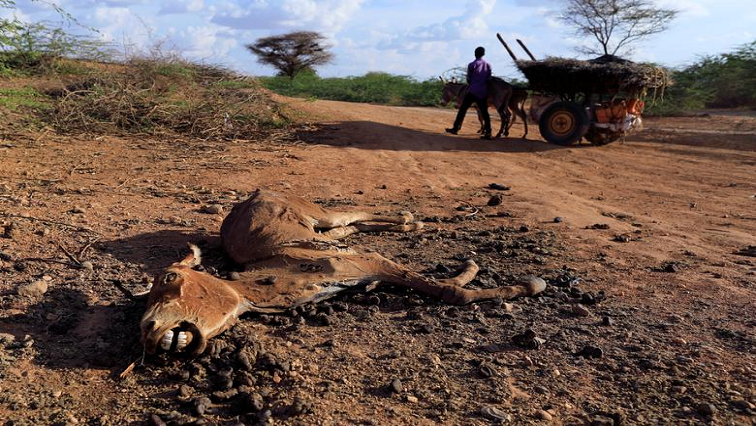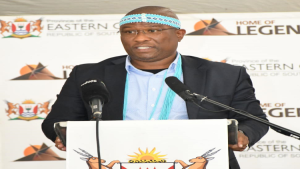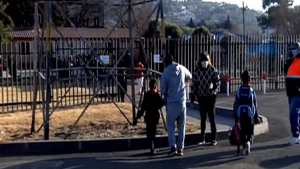Many areas in the Eastern Cape remain in the grip of a catastrophic drought. In the Karoo, boreholes and dams have dried up. The drought has been declared a provincial disaster.
Farmer Peet van Heerden is one of many who are feeling the ripple effects of the drought that has rendered parts of the Karoo barren. He says they are currently running at a loss of R600 000.
“I’m currently running of a loss of guess estimate R600 000 for this year due to loss of production, loss of animals; we had to reduce our stock numbers. In the past, we used to sell interlinks of food and fodder to neighbouring farmers. This year, we had to buy in so we have absolutely nothing. We have nothing whatsoever to feed the animals.”
Another farmer, Hendrick Wolfaardt, says the most difficult thing for him is seeing his animals go hungry.
“I think for me the most difficult thing for me is seeing my animals go hungry and some of them even dying. Economically for me, it’s not knowing where the money is going to come from to feed the animals.”
The Eastern Cape received less than 30% of its average spring rainfall between September and November. Graaff-Reinet only had 23mm of rain the entire 2019.
Supplementary feed costs farmers on average R25 000 a month. Even then, for some it’s just not enough.
In Aberdeen, the situation is the same. Not a blade of grass to be found. Farmer Dickie Ogilvie says the major issue is going to be in a year’s time when the province has rain.
“A major issue is going to be in a year’s time when we do have rain. Herd size or flock size are right down numbers wise; guys have had to offload stock to get them off the ground to try and feed just the nuclear flock to keep going. So in a year’s time or when it does rain and the guys want to get into full production, they are not going to be in a position to get into full production.”
President of the Agri Eastern Cape, Douglas Stern, says the agricultural sector, meant to be a massive economic driver in the province, has taken a severe knock.
“The situation in Graaf-Reinet has now reached a level where it’s out of control. We need more help from government, whether its loans to help the farmers who are spending all they have to keep their farmers running. Government has done some work to help us, but it’s not even close to what we need.”
It’s not only farmers who are feeling the heat. Noon temperatures go up to 30 degrees Celsius. An exhausted resident Hendrick Klaasen is desperate to quench his thirst.
“It is so hard to cope without water. In the morning when we have to bath the kids for school, there is no water. When the water returns much later in the day, it comes out green and it stinks making it difficult for us to drink. We really need other solutions to help with this water challenge. It’s a real challenge for us.”
The latest government report on dam levels suggests that the country’s water situation continues to deteriorate. 1% of water is lost weekly due to the soaring temperatures.
Eastern Cape COGTA MEC, Xolile Nqatha, says the Eastern Cape government has made emergency funding available in the short term.
“Money has been allocated to COGTA by the provincial treasurer its R100 million, but the total amount is about R174 million because R20 million of the R100 million we’ll be transferring it to the department of rural development. Because of drought, there’s not been ploughing in some other areas and as a result, they are indeed prioritised. From their savings they secured R54 million.”
Humanitarian organisation Gift of the Givers is playing a large part in relief efforts in a number of towns, including Graaff- Reinet. Organisation Spokesperson Ali Sably says Gift of the Givers has drilled nine boreholes.
“Gift of the Givers has drilled nine boreholes, eight which are at schools and the ninth one which is at the hospital. Those boreholes are a source of water points for the community to come collect and there are water tanks to pick up water and distribute in various communities. We all know the situation in hospital; operations were suspended and there wasn’t enough water to wash babies. Within less than one hour of Gift of the Givers coming in we got water, producing 160 000 litres of water per day.”
Ogilvy says the intensity and duration of the drought has been underestimated.
“Livestock numbers have been depleted by 50% and this will have a huge impact in the commodity chain down the line, affecting hundreds of thousands of people. And the seriousness of the drought we are undergoing at this point in time has not been taken seriously.”
The Depratment of Water and Sanitation Spokesperson, Sputnik Ratau, says the department has recommitted to maintaining infrastructure to ensure water provision and curb losses. It’s also making funds available.
“We are going to make sure that beyond the conference, we put monitoring measures in place to ensure that money that is distributed, goes to those it’s supposed to, that no money is wasted and that above all our plans are implemented to help those that need the water the most.”
Port Elizabeth Weather Office Spokesperson, Garth Sampson, says urban areas such as Nelson Mandela Bay are also affected, with rapidly dropping dam levels. Prospects look bleak.
“Although we have got rainfall in certain areas, it’s still not enough. We need more than 50 millimetres of rain to sort things out. The reality is that we don’t just need rain, but we need a lot of rain to fall in catchment areas for it to have any impact on the drought. It’s still very hard to predict exactly when the floods will come, they normally come during the winter season, but even that you cannot be certain of.”
Climatologists expect the next rain in early February. This however, is not expected to break the drought.
FOR MORE, WATCH VIDEOS BELOW:






